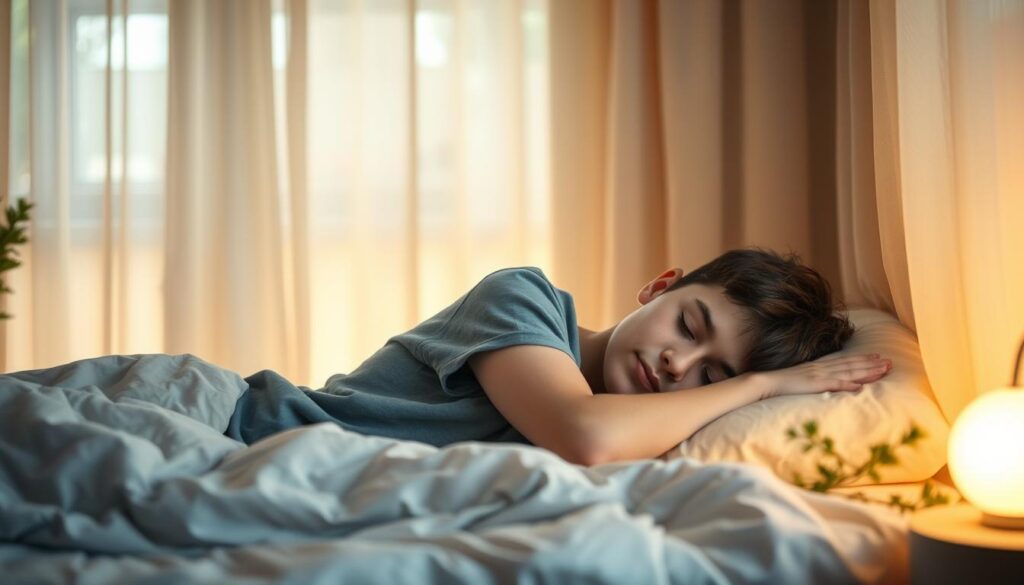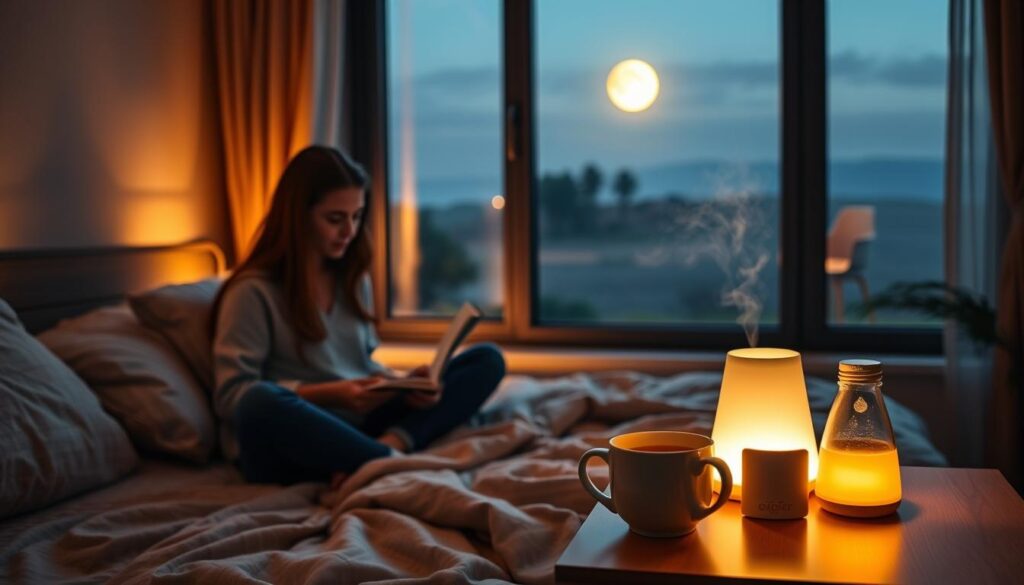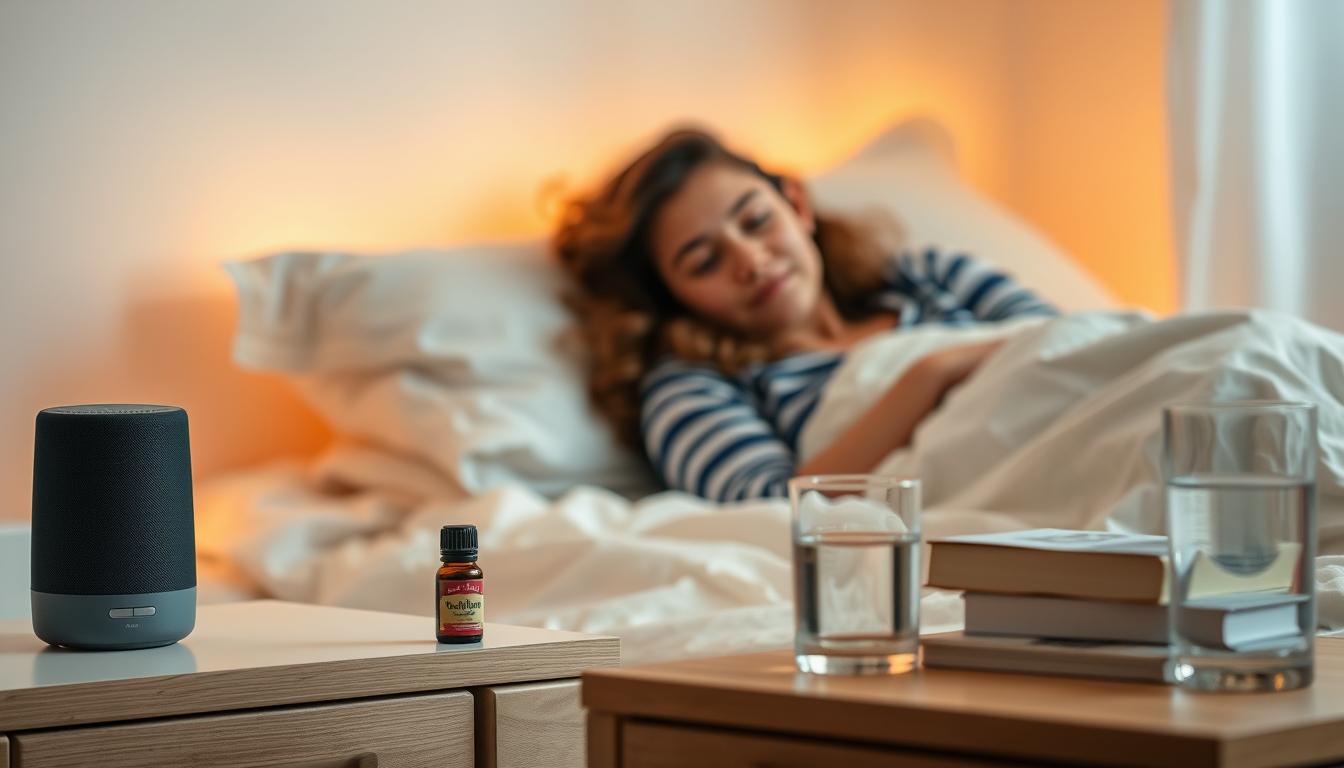Teens today face many obstacles to getting enough rest. Busy schedules, school stress, and screen time often disrupt sleep. This guide explores the best sleep aids for teenagers to help them feel refreshed and focused.
Quality sleep boosts energy, improves grades, and supports mental health. Discover natural solutions, safe supplements, and simple habits that work. Every tip here is designed to fit into a teen’s active lifestyle.
Key Takeaways
- Regular sleep helps teens stay healthy and perform better in school.
- Natural options like herbal tea or melatonin can improve sleep quality.
- Setting a bedtime routine reduces stress and supports better rest.
- Screen-free time before bed is a proven best sleep aid for teenagers.
- Consulting a doctor ensures safe use of any sleep aids or supplements.
Introduction to Teen Sleep Issues
Teens need 8–10 hours of sleep each night, but many struggle to meet this goal. Busy schedules, homework, and social demands often delay bedtimes, leaving teens exhausted. Sleep deprivation can lead to poor grades, mood swings, and health risks. While some explore teenage sleep supplements for relief, understanding these challenges is the first step toward better rest.
Common Sleep Challenges
- Late-night screen use delaying melatonin production
- School start times conflicting with natural sleep cycles
- After-school activities cutting into bedtime
Signs of Sleep Deficiency
| Symptom | Impact |
|---|---|
| Frequent headaches | Reduced focus during school |
| Difficulty waking without alarms | Relying on caffeine |
| Irritability | Social or family tension |
Recognizing these red flags helps teens and parents address issues early. Later sections will explore solutions like teenage sleep supplements and behavioral adjustments to improve sleep quality.
The Science Behind Adolescent Sleep Patterns
Adolescents’ sleep struggles aren’t just about staying up late. Science shows their biology shifts during puberty. The body’s internal clock, or circadian rhythm, naturally delays in teens, pushing bedtime and wake times later. This delay makes early school mornings a mismatch for their natural cycles.
| Factor | Impact on Sleep |
|---|---|
| Circadian Rhythm Shift | Lowers melatonin levels until later at night |
| Puberty Hormones | Increases stress hormones like cortisol |
| School Schedules | Conflicts with natural 11 p.m. to 8 a.m. sleep window |
Research from the National Sleep Foundation confirms teens need 8-10 hours nightly. Yet 73% get less due to these biological changes. A
2019 study in the Journal of Adolescent Health
found delayed melatonin release peaks at 1 a.m., not 10 p.m. as in adults.
These shifts aren’t just habits—they’re hardwired. Understanding this science helps teens and parents address sleep struggles with evidence-based solutions, like light therapy or adjusting bedtime routines to match their body’s signals.
Natural Remedies for Teen Sleep
Natural remedies for teen sleep offer a gentle way to improve rest without relying on medications. These options work with the body’s natural processes, making them a popular choice for families seeking safer alternatives.
Herbal Supplements
Several herbal options help teens unwind and sleep better:
- Chamomile tea before bed reduces anxiety and promotes calmness.
- Valerian Root extracts are known to deepen sleep stages without causing grogginess.
- Lavender essential oils in a diffuser create a soothing environment.
Melatonin and Other Natural Hormones
Melatonin, a hormone the body produces naturally, can be supplemented in small doses to reset sleep cycles. Experts recommend starting with 0.5 mg and consulting a doctor first. Consistency in timing and routine strengthens its effectiveness.
“Melatonin aids in syncing sleep patterns, but lifestyle changes are equally important,” advises the National Sleep Foundation.
Over-the-Counter Sleep Supplements for Teens
When natural remedies aren’t enough, over-the-counter (OTC) sleep supplements can offer targeted support. Brands like Nature’s Aid Sleep Tabs or Unisom Nighttime provide options containing antihistamines or melatonin. Always check labels for age restrictions—many products specify use for ages 12+.
- Melatonin supplements: Look for Country Life Melatonin or Now Foods brands with third-party testing.
- Herbal blends: Products like Yogi Bedtime Tea combine valerian root and chamomile.
- Vitamin B6 supplements: Brands such as Theralogix support sleep-wake cycles when paired with diet.
“OTC supplements can help, but consistency matters. Follow dosing instructions and avoid mixing with other medications.” — Dr. Emily Carter, Pediatric Sleep Specialist
Many supplements list California Proposition 65 compliance, ensuring safety standards. Always consult a healthcare provider before starting any new supplement, especially for teens with preexisting conditions. Check for additives like caffeine or sugar that might counteract benefits. Store supplements in a cool, dry place to maintain potency.
Best Sleep Aids for Teenagers
Choosing the right sleep aids starts with finding top sleep solutions for teens that work safely. Teens need products that address their unique sleep needs without harmful side effects. This section breaks down how to pick the best options with care.
Dosage and Safety Guidelines
- Always start with the lowest recommended dose. Follow label instructions or a doctor’s advice.
- Avoid combining supplements without professional guidance. Mixing ingredients can cause unexpected reactions.
- Check for age restrictions. Products labeled for teens (12+ years) are safest for developing bodies.
Effective Ingredients to Look For
Look for these evidence-backed ingredients in sleep aids:
- Melatonin: A natural hormone that resets sleep cycles. Opt for 0.5–3 mg doses.
- Valerian root
- Lemon balm: Soothes stress to ease falling asleep.
extracts calm anxiety without morning grogginess.
Stick to brands like Nature’s Way or Now Foods, which offer transparent labeling. Always read reviews and consult a pediatrician before starting new supplements.
Role of Lifestyle Changes in Improving Sleep
Small shifts in daily habits can make a big difference in helping adolescents sleep better. Sleeping tips for adolescents often overlook the power of lifestyle adjustments, but consistency and mindful choices create a strong foundation for restful nights.

Digital Detox Strategies
Screen time before bed disrupts natural sleep cycles. Try these steps to limit exposure:
- Set a “tech curfew” one hour before bedtime.
- Enable night mode settings to reduce blue light emission.
- Replace scrolling with reading or journaling.
Establishing a Consistent Bedtime Routine
Adolescents thrive on predictability. A calming routine signals the body it’s time to rest:
- Choose the same bedtime and wake time daily, even on weekends.
- Incorporate relaxing activities like stretching or listening to soft music.
- Avoid naps longer than 30 minutes in the late afternoon.
Importance of Exercise and Nutrition
Physical activity during the day improves nighttime sleep quality. Pair workouts with balanced meals for better results:
- Get 60 minutes of moderate exercise daily, but not within three hours of bedtime.
- Eat dinner early and opt for foods like almonds or warm milk, which promote relaxation.
- Cut caffeine after noon and limit sugary snacks that cause energy spikes.
Identifying Teen Insomnia Triggers
Understanding what keeps teens awake starts with spotting daily habits and environments that disrupt rest. Common triggers often hide in plain sight, like late-night screen use or hidden stressors. Let’s break down key factors affecting sleep:
- Stress: School pressures, social dynamics, or family issues can flood minds at bedtime.
- Caffeine Overload: Energy drinks and late-afternoon coffee disrupt natural sleep cycles.
- Blue Light Exposure: Phones, tablets, and TVs emit light that delays melatonin release.
- Irregular Schedules: Weekend all-nighters clash with weekday routines, confusing internal clocks.
| Trigger | Impact | Action Steps |
|---|---|---|
| Academic Pressure | Increased anxiety | Keep a stress journal or try 10-minute guided meditation |
| Social Media Use | Overstimulation | Set a 7 PM screen cutoff or use grayscale mode at night |
| Irregular Meals | Midnight hunger pangs | Eat a light snack with tryptophan-rich foods like bananas |
“Teens often overlook how small daily choices stack up to create sleep debt,” says Dr. Sarah Mitchell, pediatric sleep specialist at Johns Hopkins Medicine. “Tracking patterns helps pinpoint what to change first.”
Start by noting when sleep problems began and what activities coincide. Even minor adjustments like moving caffeine intake to morning hours or creating a 15-minute pre-bedwindown ritual can make a difference. Identifying triggers builds a roadmap to better rest without relying solely on sleep aids.
Creating a Sleep-Friendly Environment for Adolescents
A comfortable bedroom plays a key role in youth sleep support. Small adjustments to lighting, temperature, and noise can make a big difference in helping teens rest better. Let’s explore simple changes to turn any room into a haven for rest.
Optimizing Room Lighting and Temperature
Light exposure affects sleep hormones. Try these steps:
- Use blackout curtains to block outside light.
- Switch to warm, dim lamps 1 hour before bed.
- Keep the room at 65–67°F (18–19°C)—cool temps boost deep sleep.
Implementing Noise Control Strategies
Noise can disrupt sleep cycles. Here’s how to manage it:
- Use white noise machines like LectroFan for background sounds.
- Try foam earplugs such as Mack’s Ultra Soft for sudden noises.
- Add rugs or cork panels to absorb echoes.
| Strategy | Benefit | Example |
|---|---|---|
| White noise machine | Masks disruptive sounds | LectroFan Classic |
| Earplugs | Blocks sudden noises | Mack’s Ultra Soft |
| Sound-absorbing rugs | Reduces room echoes | Shag pile or sheepskin rugs |
Combining these tips helps teens fall asleep faster and stay asleep longer. Small changes can lead to big improvements in sleep quality.
Comparing Prescription vs. Nonprescription Options
When choosing sleep aids, teens and parents face a critical decision: prescription or nonprescription? Both paths have trade-offs. Let’s break down the facts to make informed choices.
| Factor | Prescription Sleep Aids | Nonprescription Options |
|---|---|---|
| Safety | May carry stronger side effects like dependency | Generally low risk but potency varies |
| Effectiveness | Stronger for severe insomnia | Better for mild issues (e.g., melatonin, valerian root) |
| Cost | Insurance may cover; varies by medication | Affordable OTC options like Unisom or natural supplements |
| Access | Requires doctor’s approval | Available without a prescription |
- Always consult a doctor before trying prescription sleep aids
- Nonprescription options are ideal for short-term use
- Check for drug interactions if combining treatments
Prescription drugs like zolpidem (Ambien) or eszopiclone (Lunesta) work best under medical guidance. Nonprescription choices like melatonin supplements or herbal teas offer convenience but may not address root causes. Balancing safety and results is key to finding what works without risking health.
The Benefits of Mindfulness and Relaxation Techniques
Mindfulness and deep breathing can help teens unwind and prepare for better sleep. These practices work well with effective sleep products for teenagers, creating a calm environment for rest.
“Mindfulness helps teens quiet their racing thoughts, making it easier to fall asleep,” says Dr. Sarah Lee, a sleep specialist.
Meditation Practices
Try these techniques to reduce stress:
- Guided meditation apps like Calm or Headspace offer sessions tailored for teens.
- Body scan meditation: Focus on each body part to release tension.
| Technique | How It Helps |
|---|---|
| Guided Meditations | Uses soothing sounds and voice guidance to calm the mind. |
| Body Scan | Encourages awareness of physical sensations to relax muscles. |
Deep Breathing Exercises
Simple breathing methods can slow the heart rate and signal the body to rest:
- Inhale for 4 seconds, hold for 7, exhale for 8 (the 4-7-8 method).
- Alternate nostril breathing to balance the nervous system.
Pair these exercises with effective sleep products for teenagers, like weighted blankets or calming essential oils, for deeper relaxation.
How Technology Influences Teen Sleep
Technology shapes how teens rest. Phones, tablets, and games can delay sleep by keeping brains alert long after lights are out. Screen time before bed emits blue light, which blocks melatonin—a hormone that signals tiredness. This disrupts natural sleep cycles, leaving teens groggy the next day.
A 2023 study by the National Sleep Foundation found teens using screens 2+ hours before bed slept 1-2 hours less weekly. Apps like Instagram or TikTok notifications also trigger stress hormones, making it harder to unwind. Here’s how to balance tech and sleep:
- Set a 1-hour tech curfew before bedtime.
- Use night mode features on devices (like Apple’s Night Shift or Android’s Dark Mode).
- Replace scrolling with reading or journaling pre-bed.
“Reducing screen exposure 30 minutes before bed can boost sleep quality by 20%,” says the American Academy of Pediatrics.
Parents can use parental controls to limit app usage at night. Schools like those in California now teach students to track screen time. Prioritizing offline activities helps restore healthy sleep patterns. Small changes today can lead to better rest tomorrow.
Expert Advice and Recommendations
Leading sleep experts agree that teen insomnia relief requires tailored strategies. Below are evidence-based tips to help teens reset their sleep cycles and improve rest quality.

“A stable sleep schedule is the cornerstone of better sleep. Teens need 8-10 hours nightly, but many fall short due to irregular routines.” — Dr. Jessica Meyers, Stanford Sleep Medicine Center
Insights from Sleep Specialists
- Stick to consistent bedtimes and wake times, even on weekends.
- Limit caffeine after noon to avoid disrupting sleep cycles.
- Use dim lighting 1-2 hours before bed to boost melatonin production.
Professional Health Guidelines
Major health organizations recommend these steps for teen insomnia relief:
- Screen-free zones in bedrooms to reduce blue light exposure.
- Journaling worries before bed to clear mental clutter.
- Consult a healthcare provider if sleep issues persist beyond two weeks.
| Guideline | Why It Works | Action Steps |
|---|---|---|
| Consistent Bedtime | Trains the body’s internal clock | Set alarms for both bedtime and wake time |
| Calming Routines | Signals the brain it’s time to rest | Try reading or yoga before bed |
| Daylight Exposure | Regulates circadian rhythms | Spend 30 minutes outdoors daily |
Remember, combining these steps with the sleep aids discussed earlier creates a stronger path to lasting teen insomnia relief. Always pair lifestyle changes with professional guidance for best results.
Integrating Sleep Aids Into a Comprehensive Healthcare Plan
Making sleep aids part of a full health plan helps teens feel their best. Parents and doctors work together to create solutions that fit each child’s unique needs.
Parental Guidance and Support
Parents play a key role in guiding teens toward better sleep. Tips include:
- Set consistent bedtime routines with no screens one hour before bed
- Monitor use of supplements like melatonin or herbal options
- Encourage exercise and balanced meals to support natural sleep cycles
Consulting with Healthcare Providers
Doctors can recommend safe sleep solutions. Steps to take:
- Discuss all current medications or supplements with a pediatrician
- Ask about potential interactions with existing health conditions
- Request personalized advice based on sleep studies or medical history
“A well-rounded approach balances natural remedies with professional guidance.” – American Academy of Pediatrics
Combining support from families and medical experts ensures sleep aids are used safely and effectively. Always prioritize personalized care plans.
Conclusion
Ensuring teens get enough rest starts with understanding their unique sleep needs. Natural remedies like melatonin and consistent bedtime routines can help address sleep deficiency. Creating a sleep-friendly environment with proper lighting and noise control also makes a big difference. Teens and parents should explore safe sleep aids for teenagers while consulting healthcare providers. Lifestyle changes such as limiting screens and prioritizing exercise and nutrition support better rest. Small steps like mindfulness practices or adjusting room temperature can lead to lasting improvements. By combining these strategies, teens can boost energy, focus, and overall well-being. Prioritizing sleep today helps build healthy habits for years to come.
FAQ
What are the best sleep aids for teenagers?
Some of the best sleep aids for teenagers include natural supplements like melatonin, valerian root, and chamomile. Over-the-counter options, like ZzzQuil, are also popular. Always consult a healthcare provider before starting any new sleep aid.
Are there natural remedies for teen sleep issues?
Yes, there are several natural remedies that can help improve teen sleep. Herbal supplements such as valerian root and passionflower, along with lifestyle changes like a consistent sleep routine and reducing screen time, are effective. Incorporating relaxation techniques like meditation can also promote better sleep.
How can lifestyle changes improve sleep quality for teenagers?
Lifestyle changes such as establishing a consistent bedtime routine, reducing screen time before bed, engaging in regular exercise, and maintaining a balanced diet can significantly enhance sleep quality for teenagers. These habits help regulate the body’s internal clock and reduce insomnia triggers.
What are some effective sleep products for teenagers?
Effective sleep products for teenagers include melatonin gummies, herbal teas designed for relaxation, sleep masks, and white noise machines. These products can help create a calming bedtime environment and promote better sleep hygiene.
How do mindfulness and relaxation techniques help with teen insomnia?
Mindfulness and relaxation techniques, such as meditation and deep breathing exercises, can reduce anxiety and stress, making it easier for teenagers to fall asleep. These practices help calm the mind and promote relaxation, contributing to better overall sleep quality.
What should I look for in teenage sleep supplements?
When selecting sleep supplements for teenagers, look for ingredients like melatonin, magnesium, and glycine. It’s important to consider product safety and efficacy, so always read labels carefully and consult with a healthcare professional if you have concerns.
How can parents support their teens in developing better sleep habits?
Parents can support their teens by encouraging consistent bedtime routines, providing a sleep-friendly environment, and discussing the importance of sleep hygiene. Open communication about challenges and potential solutions can help teens feel supported in managing their sleep better.
When should I consult a healthcare provider about my teen’s sleep issues?
If your teenager experiences persistent sleep problems, such as chronic insomnia, excessive daytime sleepiness, or significant changes in sleep patterns, it’s important to consult a healthcare provider. They can help identify any underlying issues and recommend appropriate treatments or therapies.
